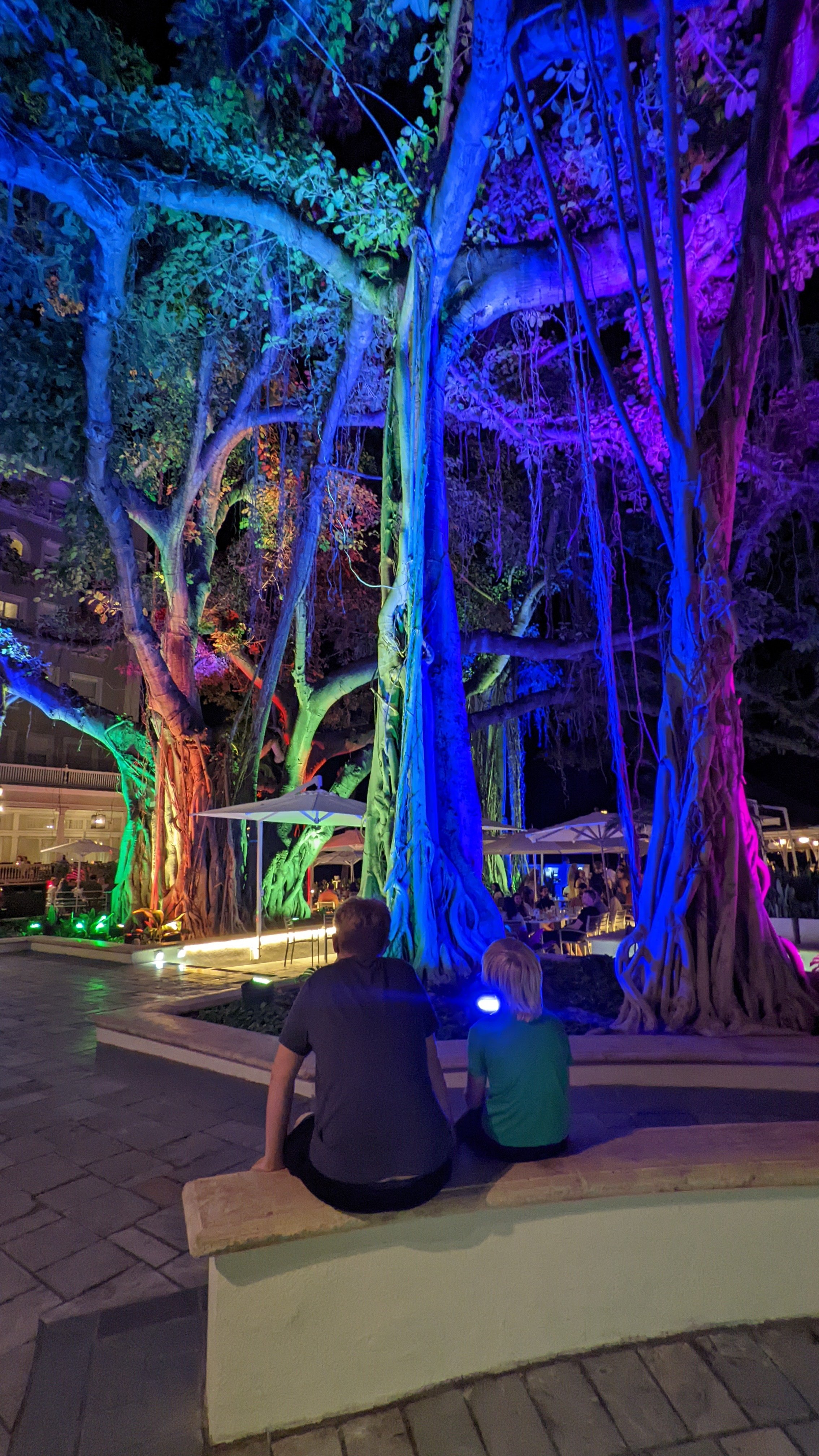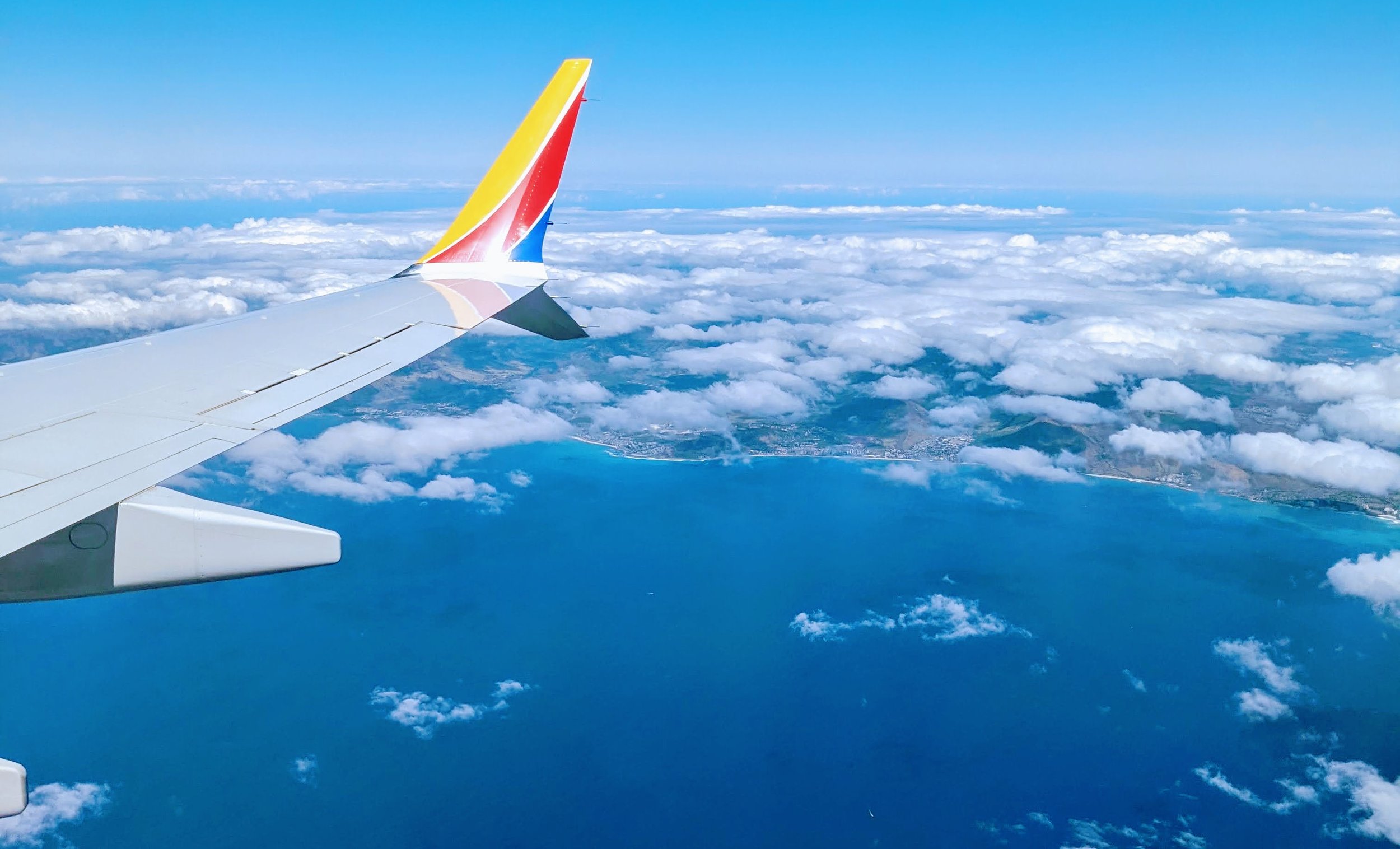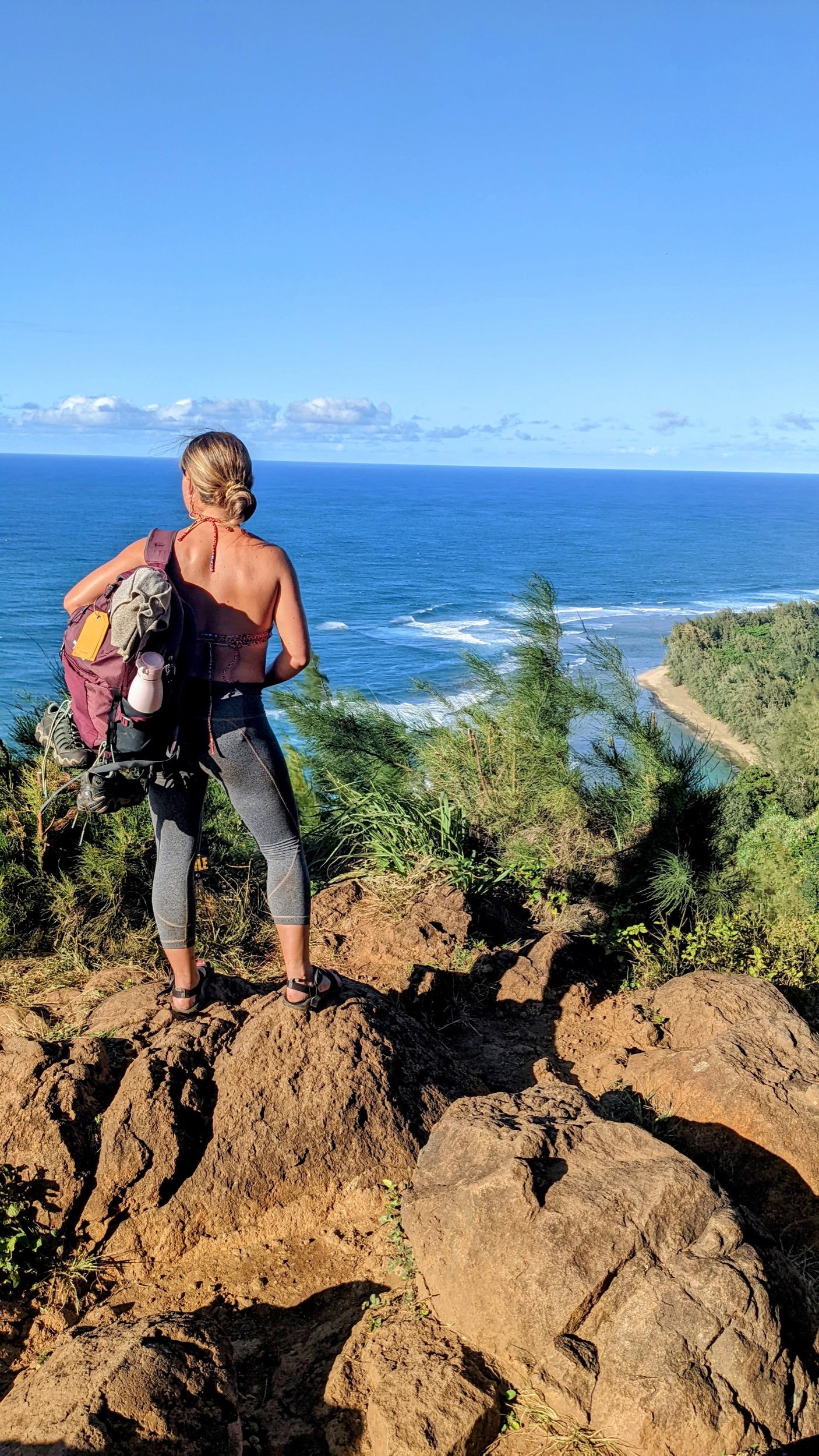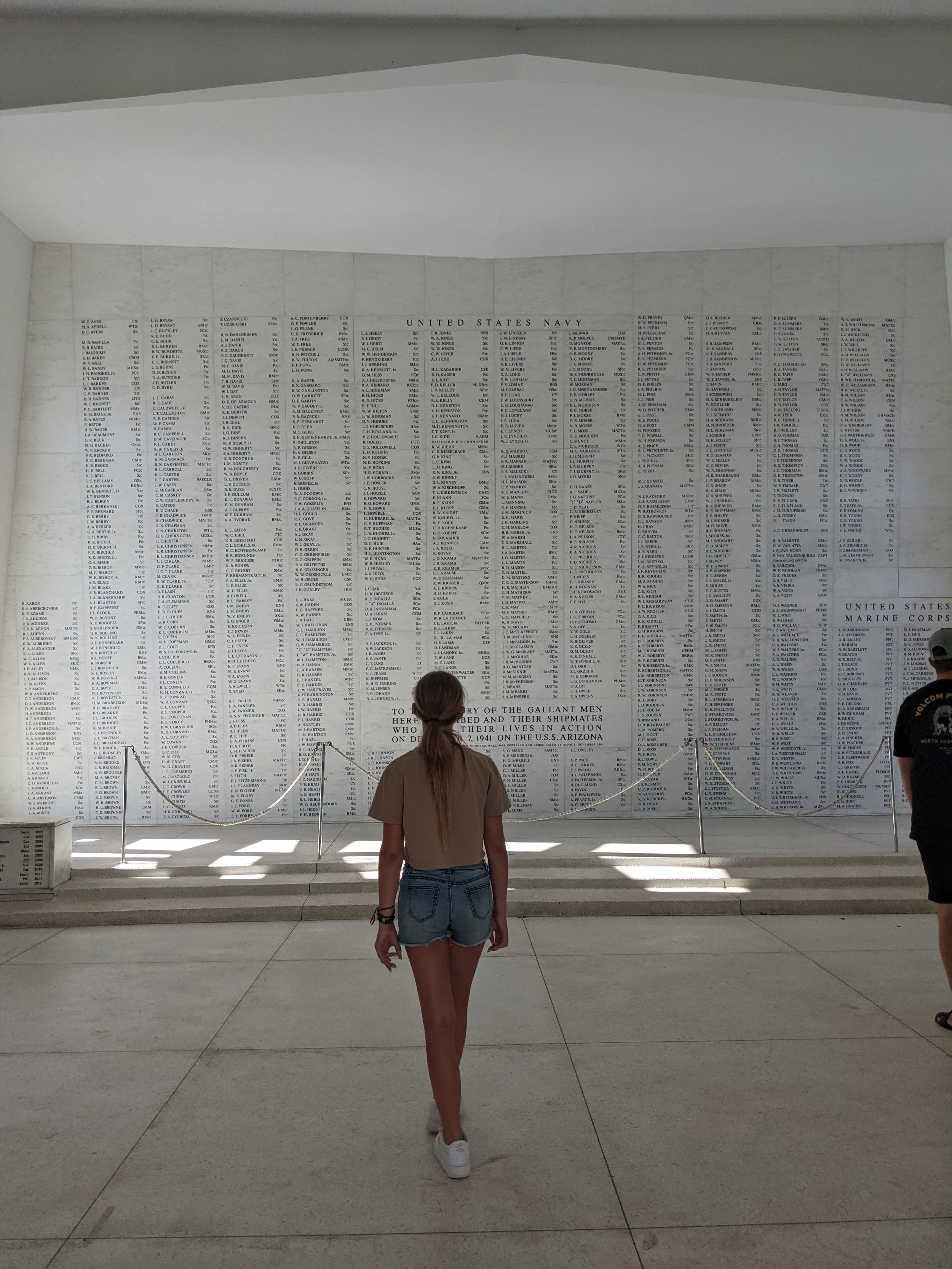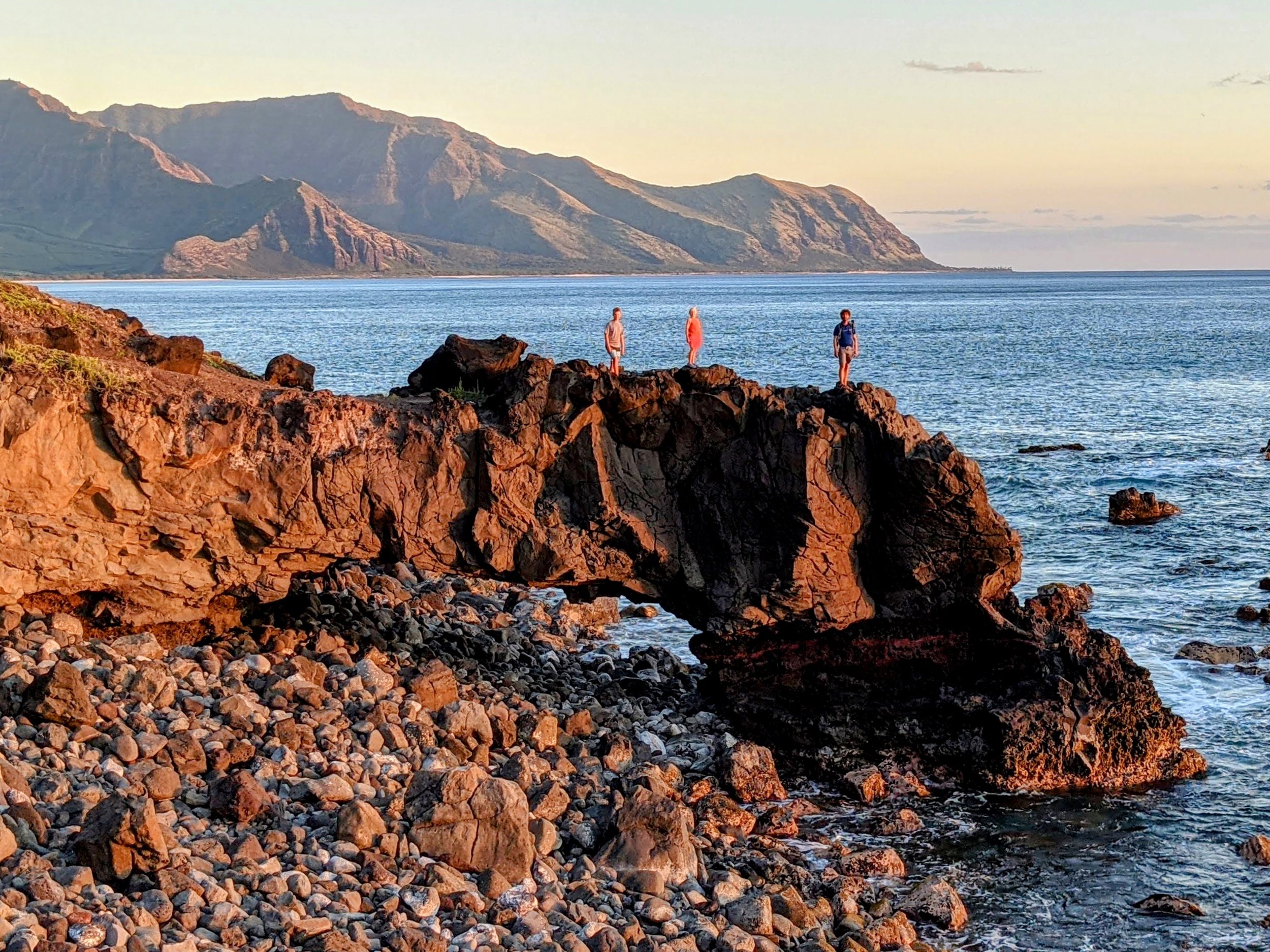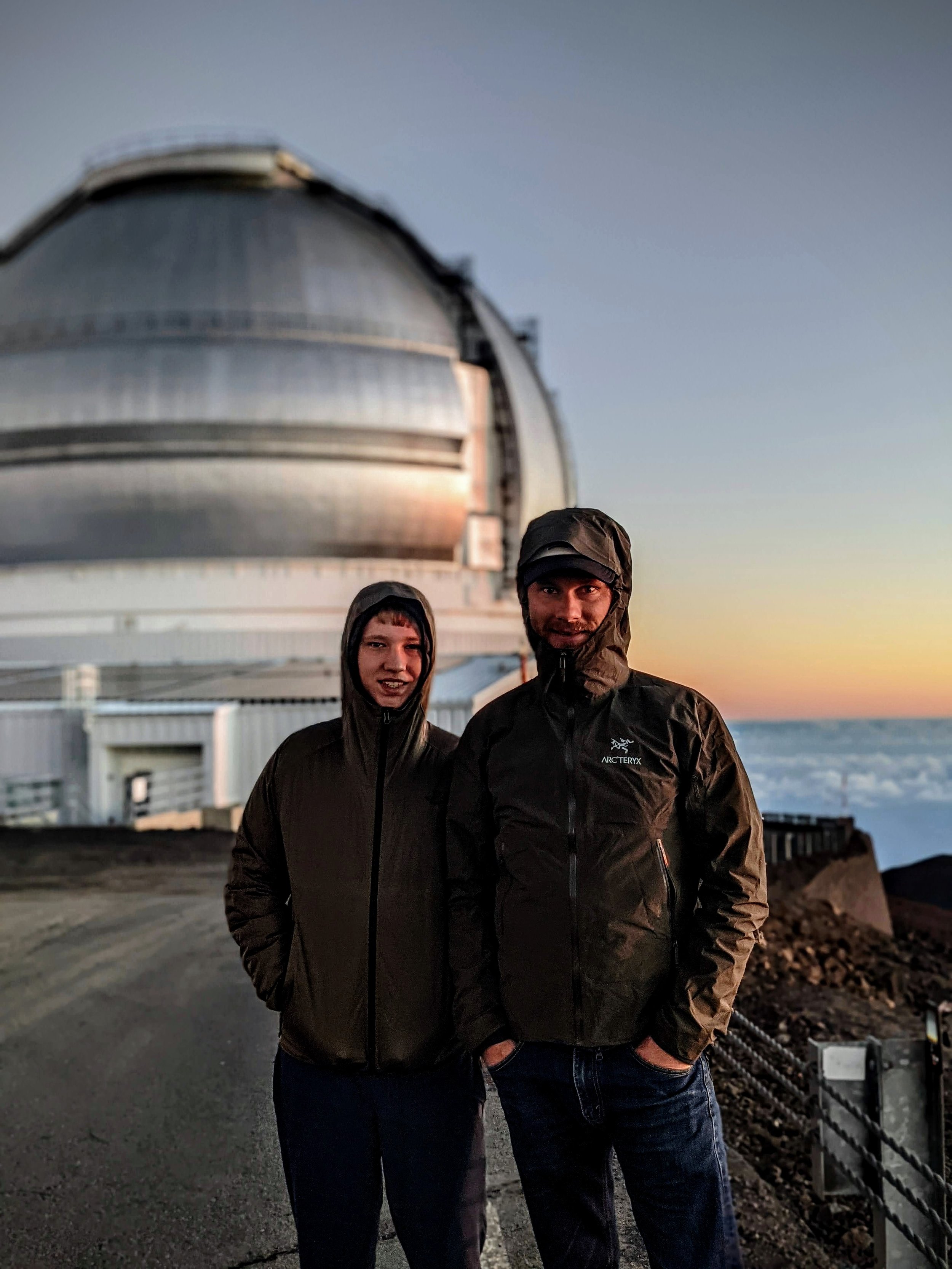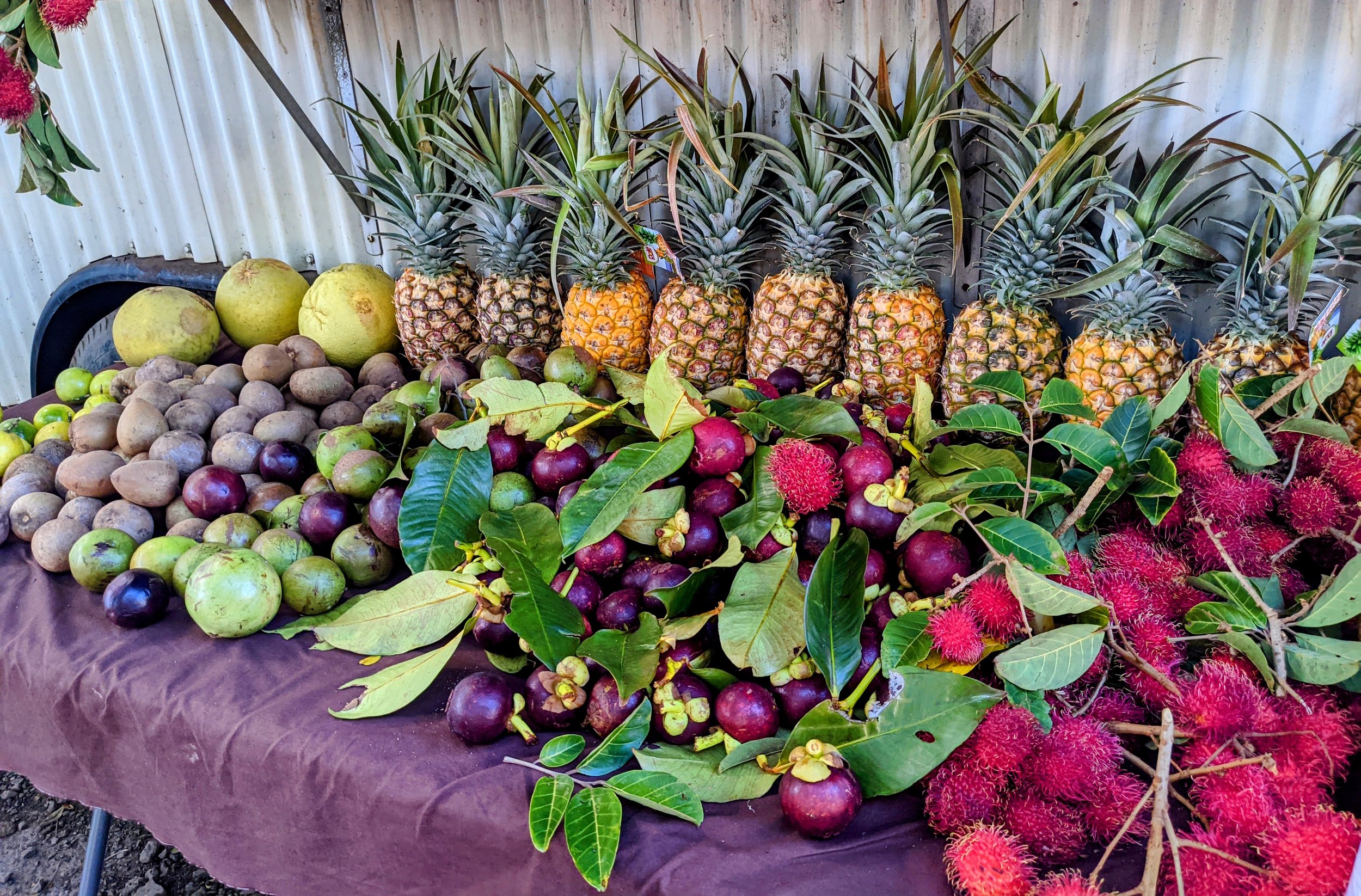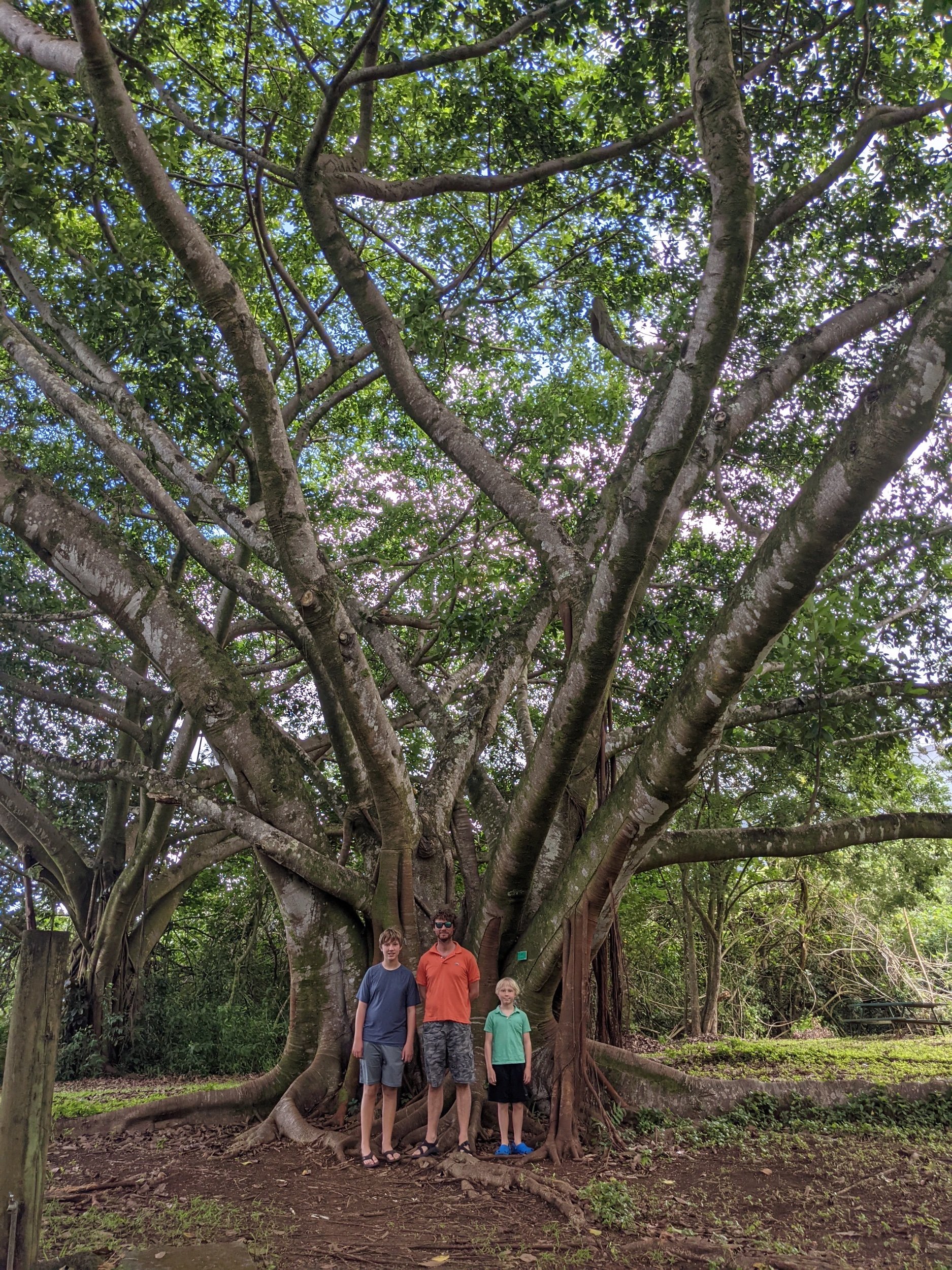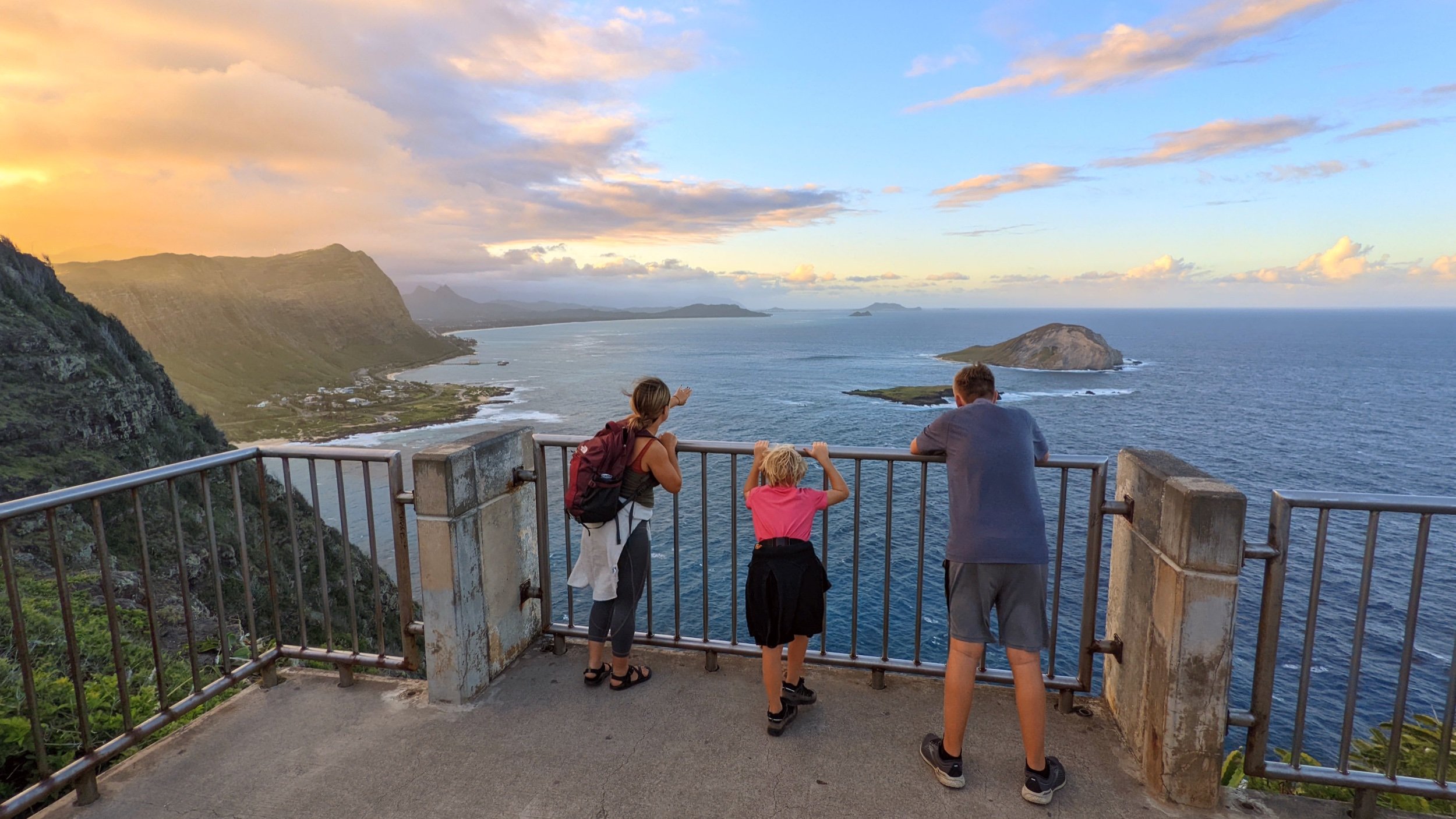Which Hawaiian Island is Right for You?
Wendi Surfing in Hanalei Bay, Kauai, Hawaii
Why Hawaii
Hawaii is so different from other US states that it is almost like visiting a foreign country. Grown from lava spewing forth from volcanoes that sprung up in a hot spot on the floor of the Pacific Ocean, the Hawaiian islands sit isolated from any other land mass. Hawaii is almost as close to Asia as it is to the continental US. The heavy influence of Japanese, Chinese, and Korean cultures combined with a unique native culture and the connection to the United States have shaped Hawaii into a place that is like no other. The enticing climate of the islands with highs topping out anywhere from 79-87 year round, lush mountains, plenty of fresh water, warm trade winds, beautiful beaches, perfect waves, and nearly constant ocean temperatures have rightly earned Hawaii the title of Paradise. I can only imagine how excited and lucky the Pacific Islanders who crossed the Pacific Ocean in canoes felt when they stepped upon these majestic shores.
So, should you visit Hawaii?
Obviously, the answer is “yes”, but with a few caveats.
You should consider picking another vacation spot if one of the following applies to you.
If you just want to sit on a nice beach and relax in calm waters for a week, go to Florida, Mexico, or the Caribbean. All of these places are easier to get to, cheaper, and have warmer, calmer ocean water.
If you have less than 10 days to vacation, go somewhere else. Unless you live on the west coast of the US, getting to Hawaii will likely take you upwards of 18 hours and $1,000 per person in plane tickets. The time change of 5 hours from the east coast is no joke, so you will probably feel weird and jetlagged for at least a full day on either side. In my opinion, it isn’t worth it to come for only one week.
If you have little kids (less than 8), I would probably wait a few years to come to Hawaii. First of all, the flights are long and tough for little kids. Secondly, they probably won’t appreciate that it is any better or different than Florida but you’ll be paying twice as much and resenting the fact that they can’t appreciate it. Finally, the rough ocean conditions are not ideal for little kids.
So, why fly halfway across the Pacific Ocean to visit Hawaii?
Hawaii Shrouded in Clouds from the Southwest Intra-Island Flight
1. Variety. If you are looking for a beach vacation mixed with hiking, biking, volcanoes, surfing, kayaking, waterfalls, and more, then Hawaii is the place for you. With beautiful beaches, green covered mountains, lush valleys, rainforests, and abundant sea life, you can create an action packed and varied vacation here. I love a good week at the beach doing nothing but laying in a lawn chair and eating and drinking, but I also love more adventurous vacations where I try new things and feel physically tired at the end of the day. In Hawaii you can strike the right balance between the two.
Waimea Canyon, Kauai, Hawaii
2. The food. For more on Hawaiian food, see our post on “Seven foods to try in Hawaii”. The strong Asian and Pacific island influences, fresh fish, fresh fruit, and solid American options set the standards very high here. They have also fully embraced food trucks, diners, and dives so you can get amazing food without having to change out of your bathing suit.
3. The Aloha Spirit. In general, I find people are simply happier here. No one is in a rush. People are less stressed and their mentality is infectious, in a good way. They are nice, but not overly nice.
Fire on the Beach at Sunset in Hanalei Bay
4. Whales and Sea turtles. My kids are really questioning all of that “endangered species” business because we saw both of these amazing creatures on the daily here.
Hawaiian Green Sea Turtle at Carlsmiths Beach, The Big Island Hawaii
5. Volcanoes. The active volcanoes on the Big Island and the visible consequences of volcanic eruptions in the relatively recent history of the Earth are beautiful and an impressive reminder of the power of these natural forces. For more on Volcanoes, see our post on “48 hours on the Big Island”.
6. Surfing. Modern day surfing was born in Hawaii. It is a deep and important part of the culture here. There are endless surf breaks and overall friendly locals here willing to give you advice or a lesson. During our month here, we were able to witness professional surfers ride waves that would take down a small building, saw Kelly Slater win his 11th Bonzai Pipeline just 6 days before his 50th birthday, and watched Bethany Hamilton teach her kids to surf on the same break we were surfing in Hanalei Bay. If you want to try surfing, Hawaii is the spot.
Wilson with the 7 foot Honolulu Board Company Foamie, a Great Board for a Budding Grom
7. The culture and history. From attending a luau, wandering around the historic Lahaina courtyard, visiting a pineapple plantation, to touring Pearl Harbor, there are abundant ways to learn about and experience the unique history of these islands.
8. You can visit a state that feels like visiting a foreign country but you don’t have to deal with customs and everyone speaks English (albeit with an accent as thick as an Eastern Kentuckian).
So, you have decided to visit Hawaii. Which island is right for your vacation?
There isn’t a one-size fits all answer to this one. I’m going to try and describe the vibe and layout of each island and then give the pros and cons of each. At the end, I will conclude with some final thoughts.
Maui
Maui’s Vibe:
Before traveling to Hawaii, when I imagined what Hawaii would be like, it was Maui. Maui has amazing resorts. The spa at the Grand Wailea has set the standard for all spas in my mind and nothing else has ever come close. Imagine sparkling pools with fountains flowing into them, ocean breezes drifting through an open air restaurant on the ocean, unlimited fresh fruit, fresh ahi served poolside for lunch, green mountains on one side, ocean on the other side, daily rainbows, and all of it on your parent’s tab. That was my first time in Hawaii and it’s nothing but delicious fond memories. From the airport to the resorts to the restaurants, Maui is pristine. You will never regret being there. It is beautiful and perfect.
The Scene at Down the Hatch in Lahaina Maui, Hawaii, Featured on Diners, Drive-ins and Dives
Maui’s layout:
Maui follows the typical Hawaiian Island weather patterns. The southwest is sunny and drier, while the northeast gets more rain, bigger waves, and more lush vegetation. The nice resorts and tourist destinations dot the southern and western coasts. Lahaina, which was the original capital of Hawaii and a bustling whaling port in the 1800s, is located on the Southwestern coast and retains it’s historical charm. The surfers hang on the northern coast. And then there is Hana on the northeast, with its secluded black sand beach and winding scenic road. In the interior of the island, you will find the West Maui mountains in the western half and Heleakal, the volcano in the eastern half. From Maui, you can see the adjacent smaller islands of Molokai and Lanai which add depth to the endless blue of the Pacific Ocean views. The best spot for whale watching in all of Hawaii is in the channel between Maui, Molokai, and Lanai.
Bailey, Wendi and Gus leaving the Lahaina Town Square, Maui
Maui’s Pros:
Amazing resorts.
With good surfing for all levels, surrounding reef for snorkelling/scuba diving, hiking, a variety of nice beaches, rainforest, and waterfalls, Maui has it all. Anything you might envision wanting to do in Hawaii, Maui has it.
Great food. Maui has a higher concentration of killer restaurants than the other islands. Although you can find great food on all of the islands, you have to do a bit more research. In Maui, there are amazing restaurants everywhere.
Pristine facilities and lack of poverty and homelessness encountered on the other islands. You can feel this the second you step off the plane, because the airport itself is much nicer than the other islands.
Maui’s Cons:
Cost. Maui is very expensive. There are only a few budget accomodations and, in Maui, budget means $400 a night for a family of 5 like us. If you are on a tight budget, I wouldn’t plan a vacation to Maui. Everything is expensive and you will just be stressing about paying the high prices the whole time. Go to Maui when you have the funds to do it and you want to splurge.
Relative lack of local culture. After spending a month in Oahu and then revisiting Maui, the relative lack of locals compared to tourists really stood out. You can get more of a local vibe on the north shore and in Hana, but there is a serious lack of the multigenerational Hawaiian families that we saw in Oahu. I am guessing this has to do with a lack of affordable housing, which is decidedly absent on Maui.
Maui Summary:
Go to Maui if you want to spend a week at an amazing resort in paradise and you have the funds to do it.
Kauai
Kauai’s Vibe:
Of the 4 main Hawaiian islands, Kauai is the least developed. With a total island population of 73,000, the biggest city on the island, Kapa’a, is still small by most standards. As such, Kauai feels like a rural, less developed, less polished version of Maui. Between the few beach towns on the island, you will find miles of farmland and lush, sparsely inhabited valleys. You are more likely to find solitude in Kauai but also more likely to have a flock of chickens roosting in your backyard.
Wendi at the 1st Mile Marker of the Kalalau Trail Na'Pali Coast
Kauai is perhaps most famous for its rugged but amazingly beautiful Na’Pali coast on the Northwestern side of the island. There are no roads in this portion of the island and it can only be seen by boat, by helicopter, or by foot. With 9 state parks and 97% of undeveloped land, Kauai is home to the most advanced and varied hiking trails of the islands. All of the islands have great hiking, but Kauai has some truly spectacular trails and views. Kauai is also the oldest island. As a result, a lot of the lava rock has turned to sand, and most of the beaches are composed of sand rather than rock.
Kauai’s Layout:
The nicer resorts on the island can be found in Poipu, on the sunny southern coast, or in Princeville, on the Northeastern Coast where there is more rain but you are closer to the Na’Pali coast. In between the two on the East coast, there is Lihue, which is where the airport and few big box stores on the island can be found, and then Kapaa, which has some slightly more budget resorts in a laid back town. Hanalei Bay along the north shore is Kauai’s hub for surfing and a hotspot for raising little surfers (we saw more kids surfing each day here than we saw in 30 days on Oahu). Smaller beach towns dot the coastline, but very few rental accomodations can be found in the smaller towns. The Waimea River runs through the center of the island and has carved one of the most impressive canyons on earth.
Hanakapi Falls on the Na'Pali Coast, Kauai
Kauai’s Pros:
The Na’Pali coast and epic hiking trails. The hike to Hanakapi Falls on the Na’Pali coast is one of my top 10 favorite hikes. We didn’t do the full coast and backpacking experience this time, but we will.
Less developed, more rustic, rural, vibe. With very little light pollution, the stars in Kauai were amazing.
The Waimea Canyon. This is the second largest canyon in the US, behind the Grand Canyon and it is really impressive.
Slightly more affordable than Maui.
Kauai’s Cons:
Lack of amenities. Just like any rural town, most of the towns in Kauai lack real grocery stores and you may have to drive an hour round trip to pick up a decent steak for dinner.
Lack of accommodations. There just aren’t that many places to stay, especially in some of the most quaint beach towns.
Less polished than Maui. The facilities and infrastructure aren’t as nice here. You will see a surprising number of run down buildings and the airport feels like it hasn’t been updated since the last century.
Kauai’s Summary:
Go to Kauai if you want to visit a less developed island or if you are interested in doing some of the best hiking in Hawaii.
Oahu
Walking Waikiki Beach, Oahu After Dark
Vibe: I have to start with a disclaimer. We spent 30 days in Oahu and only spent 2 of those days on Waikiki in Honolulu proper. This means that our experience of Oahu was vastly different from that of 95% of tourists to the island. That being said, we got a very good sense of the island during our time there. Waikiki is exactly what you would expect. It is a beautiful bay and beach suffused with old school surfing culture and lined with high rise condos and designer stores. It feels a lot like south Florida but with a Hawaiian shirt twist. Where we stayed, in Ewa beach, on the other side of Pearl Harbor, we had a great view of Honolulu. From afar, it is a beautiful city situated along the large bay, with Diamond Head crater to the east, mountains to the north, and tentacles of houses spreading out from the city into the valleys between the mountains.
Of the 1,300,000 permanent residents of Hawaii, 1,000,000 of those live on Oahu. Even though the island is a hot spot for tourism, the locals to tourist ratio is a lot higher on Oahu than the other islands. Outside of Waikiki, Oahu is the only place where there were less white people than non white people on the beaches. Unlike the other islands, Oahu actually has a middle class. Although the Asian cultural influence can be seen on all of the islands, it is more prevalent on Oahu. As expected, given its role as a center for the development of modern day surfing, the surfing culture also takes a central role in the cultural identity of the island. A final influence that has shaped Oahu’s unique identity is a long-standing military culture and presence. This can be seen in the multiple Pillboxes around the island, the multiple military bases and barracks, and at Pearl Harbor.
Oahu’s Layout:
Honolulu, its suburbs, and Pearl Harbor with surrounding military bases make up most of the southern coast of the island. Along the southwestern coast, nestled between industrial ports and a power plant is the completely pre-planned resort town of Ko’olina with its man-made, protected lagoons, and multiple high end resorts. Heading further west from Ko’olina there are multiple beautiful beaches that are rarely ever seen by tourists because they are the site of extensive homeless encampments. Some great surfing and some of the best secluded beaches are found on this side of the island, but the towns that dot them are run down and poverty stricken.
Kailua at Sunset from the Pillbox Trail from Lanikai Beach, East Oahu
Heading east from Honolulu, you will encounter the majority of the more upscale beach towns of Diamondhead, Lanikai, Kailua, Kane’ohe, and Laie. These towns are centered around beautiful, but windy beaches. The north shore of Oahu is the surfing Mecca of the world, and home to Pipeline and Waimea Canyon with some of the most famous and largest swells in the world. The north shore is dotted with small surf towns but there are very few large resorts.
Oahu’s Pros:
Great surfing and surfing culture.
More affordable accomodations. There are tons of high rise condos on Waikiki that are surprisingly affordable. If you want to stay in one of the more upscale resorts, you will be paying prices similar to the other islands, but normal, middle class people can afford a vacation in Oahu.
More locals, giving you a better feel for what the Hawaiian identity entails.
Easier access with direct flights into Honolulu.
More varied and budget food options.
Pearl Harbor. Seeing the memorial and museum at Pearl Harbor really helped us to understand the impact and importance of that day.
Oahu’s Cons:
Poverty and homelessness are way more prevalent here than I expected.
Crowds. If you are exploring the popular beaches, like Waikiki, expect to be doing so with hundreds of other people. That being said, you can find some beautiful secluded gems if you are willing to get off the beaten path.
Traffic. Honolulu traffic is downright horrible. Avoid it at all costs.
Oahu’s Summary:
Visit Oahu if you are on a budget and you want to get a better feel for the diverse and dynamic culture of multigenerational Hawaiian families.
The Big Island (Hawaii)
The Big Island’s Vibe:
The Big Island is the youngest of the Hawaiian islands and still forming by way of active volcanic activity. Most recently, the Mt. Kilauea eruption of 2018 increased the landmass of the island by 875 acres. Due to the young age of the island, the volcanic rock hasn’t been exposed to the same years of battering waves as the older islands, resulting in a predominantly rocky, rather than sandy coastline. There are still two active volcanoes on the Big Island, Mt Kilauea and Mauna Loa. Additionally, the second largest island volcano on earth is found on the Big Island, Mauna Kea. (See Summiting Mauna Kea for more details). The relatively young age and ongoing volcanic activity really shape the Big Island, both literally and figuratively.
Gus in the Center of the Kilauea Iki Crater in Volcanoes National Park, Big Island Hawaii
The Big Island’s Layout
Hilo, located on the east coast, is the largest city on the Big Island. It has an airport and is the jumping off point for exploring Volcanoes National Park. The vast majority of the beaches along the east coast are rocky, thus making it a poor choice for high end beach resorts. All of the higher end beach resorts can be found along the west coast in Kailua-Kona. There are a few places to stay in Volcanoes, which is a small town right outside of the national park, but there are almost no amenities there. A few small towns are scattered along the northern and southern coasts, but they have very few accommodations and amenities. For full disclosure, I have not been to the Kailua / Kona side of the island and thus, cannot compare it to other Hawaiian towns.
The Big Island’s Pros:
Volcanoes. Seeing these powerful forces and the relatively recent consequences of their eruptions is mind-blowing. It’s totally worth spending at least 2 days on the Big Island just to see volcanoes.
Budget accomodations. There are several relatively cheap places to stay in Hilo, but you get what you pay for.
The food in Hilo was surprisingly good.
I have read good things about the Manta Ray experience in Kailua / Kona but haven’t experienced it myself.
Swirling Volcanic Rock at the Pu'uloa Petroglyphs
The Big Island’s Cons:
Rocky shoreline. The term “beach” is used very loosely here and the beaches on the east coast are barely worth visiting.
Poverty and homelessness. Some parts of Hilo are really run down and our only encounter with an aggressive, mentally ill homeless person occurred in Hilo.
The weather. It rains 260 days a year in Hilo. It was a bit of a bummer to leave the ever-perfect weather of Ewa Beach for the rainy, gray weather of Hilo.
The Big Island’s Summary:
Go to the Big Island to see volcanoes, but I wouldn’t spend more than a few days in Hilo given the rainy weather, rocky shores, and run down feel of the town. If you are going to pick the Big Island as your main island destination, I would spend 4-5 days in Kailua-Kona and 3-4 days in Hilo.
Final Thoughts:
If you have ample resources and can only visit one island: Maui.
If you want to see Hawaii but you are on a budget: Oahu.
If you are into hiking or less developed destinations: Kauai.
If you want to see volcanoes: The Big Island.
Ideally, when planning a trip to Hawaii, I would recommend picking two islands and taking a weekday Southwest flight between the islands if possible. The inter island flights are super easy and cheap and you get the bonus aerial view of the islands. When we come back, I will likely plan 9 days in Maui and 3 days in Kauai to hike the Na’Pali coast. My advice would be to pick one island for a longer stay (7-10 days) and then a second island for a shorter stay (3-4 days) just to hit the high points.
What is your favorite Hawaiian island and why? Share in the comments.

